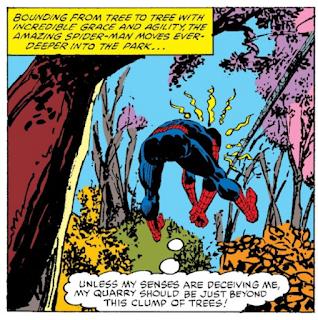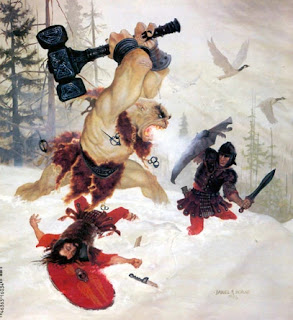One thing I find myself needing a lot as players sandbox their way around the map is "ordinary" places.
You might roll a random encounter as they crawl across a hex and need to know what the landscape around that hex is.
A player might, after the encounter or any time along a multihex journey, ask if there's a town or an inn nearby.
Or a body of fresh water.
Or a hill.
Or etc. etc.
Now you can just make it up on the spot or roll a simple chance, but sometimes its nice to have a regular place with just a little extra playable depth built in.
So: I have these two random generators for "boring" places, specifically with an eye towards this use case in sandboxes.
One Important Note
I don't, by-and-large, use these generators to make places and then, before play, stick them on the world map. The world map is full of interesting destinations and odd places one might encounter along the way, but these are fairly normal and the map is large so there's a good chance an area generated this way is never getting used if it is simply placed in any old hex.
These places are insignificant--at least until activated by players doing something or having something done to them--so they only go on the map after you use them in a session. They are "floating" locations, not interesting enough to start out as plot points but hopefully just interesting enough to maybe one day be promoted into one.
Making them is an oddly hypnotic way to spend a lazy evening though I tell you what. Make four or six of them and just have them ready and pick when it's time to insert some drama before the party gets where it's supposed to be going.
Another thing I would not necessarily do is automate them--I would not plug the tables into a computer and have it spit out a jillion of these and pick one at random when you need one. Two reasons:
1. Experiencing and re-experiencing all the options you read about as you generate is a helpful way to think about these kinds of areas when it comes to actually running the game.
2. Having a short stack of areas you recognize and remember making will allow you to pick the one that'll be most interesting for that specific party on that specific day when its actually game time.
Wilderness Encounter Area Generator
So this one is specifically for adding just a little meat and depth to a random wilderness encounter. You don't just go "you come upon a..." but there's some context, foreshadowing, and perhaps nearby resources for dealing with the situation or fallout therefrom.
First, there's a sort of flowchart for when you "zoom in" at the beginning of moving from "you travel for several days" to "ok, you come upon...". Since this is placed in a sandbox the PCs might enter the area from any direction, so there are some choices built in.
Distances are abstract, you begin "near" the encounter, but you can decide exactly how near when generating.
Start the PCs in the cardinal direction box most appropriate to the direction they entered from and roll the appropriate die:
 |
| Click to enlarge |
Pink boxes are, like it says, optional.
Second, populate the boxes as it says below:
 |
| Click to enlarge |
This is built for the wilderness in Broceliande, which is primarily a kind of fairy-tale forest, but you cold obviously tweak it for wherever your players are currently hanging out.
Alright, there is that thing.
Second we have a...
Random Fully-Mapped Hex Generator
This makes 6-mile hexes with stuff in them. You gotta draw them so, crucially, the generator is in a very specific order so that each layer you draw will influence the next layer laid down in a way that makes sense. You don't, for instance, want a dam in a hex with no river, or a road in an unmapped wilderness.
This generator's especially good if you want the town or inns that PCs stop at on the way to a more important destination to have some context.
Again, this generator's for Broceliande, you'd want to tweak the numbers for other environments.
First you roll all the kinds of dice (D4, 6, 8, 10, 12, 20) to see if a these categories of feature in boldface are there at all:
Topography (Does the land go up and down?) (3 in 4 chance)
Body of Water (11 in 12)
Vegetation (19 in 20)
Civilization (1- None 2-Ruins only 3-Nothing human or demihuman 4-Nothing organized 5-8 Yes)
Resident Creatures? (Besides anything randomly encountered)
1-Includes monster (for example: an ogre)
2-Includes interesting creature(s) (for example: pink rabbits)
3-4 Incudes predatory animal(s) (for example: wolves)
5-Boring animal(s) only (for example: deer and other local prey animals)
6-No animals
Magic (Is there some landscape feature or other thing with weird magic properties somewhere in the hex) (1 in 10)
Then, if there is, roll specifically what features are present and draw them--if a feature is present then its up to you whether that's one or many. Like if it says there's a river that can be one river or seven--whatever you like. Examples of fully-drawn hexes are below.
Topography? (Does the land go up and down?) (3 in 4 chance)
Roll separately for each feature that might be in the hex:
Hill (3 in 4)
Valley (3 in 6)
Cave (1 in 8)
Mountain (1 in 10)
Cliff (1 in 12)
Volcano (1 in 20)
Weird/impressive Rock Formation (1 in 20)
WATERFALL (1 in 20 only if there's also a body of water in the hex)
Body of water? (11 in 12)
River (3 in 4)
Pond (5 in 6)
Lake (5 in 8)
Stream (7 in 10) (You don't have to draw in all the streams)
Swamp (2 in 12)
DAM (See Civilization)
WATERFALL (see topography)
BRIDGE (See civilization)
Vegetation? (19 in 20)
Dense Forest (3 in 4)
Overgrown Orchard (1 in 6 if the Civilization level below is at least 2)
Medicinal Plants (1 in 8)
Edible Plants (9 in 10) (only note a lack of edible plants)
Tall tree with view of surrounding hexes (1 in 12)
Hollow tree (1 in 20)
Civilization? (1- None 2-Ruins only 3-Nothing human or demihuman 4-Nothing organized 5-8 Yes)
Path/Trail (2 in 4)
Home (2 in 4)
Well (2 in 4)
Hamlet (1 in 4)
Ancient Ruin (1 in 4)
Wall (1 in 4)
Inn (1 in 4)
Church (1 in 4) (Roll D20: 1-8 Vorn 9-15 Tittivila 16-PC-related faith of your choice 17-18 Obscure/neutral faith 18-New faith 20-Evil faith)
Village (1 in 6)
Tower (1 in 6)
Statue (1 in 6)
Hunter’s Lodge (1 in 6)
Fort (1 in 6)
Castle (1 in 6)
DAM (1 in 8 if water)
BRIDGE (5 in 6 if water)
Road (3 in 8) (none if only ruins)
Store (1 in 8)
Old hunter’s traps (1 in 8)
Old aqueduct (1in 10)
Cemetery (1 in 12)
Monastery (1 in 12)
Old Siege Engine (1 in 20)
Old Asylum (1 in 20)
Old Prison (1 in 20)
Old Library ( 1 in 20)
MINE (1 in 20 if there's Topography)
Resident Creatures? (1-Monster 2-Interesting creature 3-4 Predatory animal(s) 5-Boring animals 6-No animals)
Unless the result is 5 or 6, pick an appropriate kind of creature .
Magic? (1 in 10)
There's no good way to automate this--if you've got magic, look at the hex you've got so far and decide what the enchanted part is and how it is enchanted.
Also, no matter what, there's a 1 in 20 chance of a freshwater spring somewhere in the hex.
Here are the examples, click to enlarge.
 |
Once it told me there was a monster in the hex I generated
a random wilderness encounter using the Book of Jerks,
it told me there was a grey elf warband. I rolled their
stats individually and the low Str and Con on the
fighters and generally bad stats suggested there must be some
reason for that. |
 |
| Perfidious owls are just owls that steal things, especially magic items |
Once I rolled "new faith" for the church I
made the Carrion Child using the
 |
Once I got a hollow tree and "interesting animals" I figured
the animals probably lived in the tree |
 |
| Figured the library was the most fun place to make a wolves' den |
 |
When I got roads and a cliff I figured the locals probably
carved some steps into it |
 |
The Black Grip is the church of my party's necromancer
PC, I figure running randomly into a monastery
dedicated to his minor cult would be fun, since
he hasn't met any of the church hierarchy yet |







































